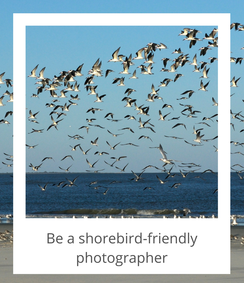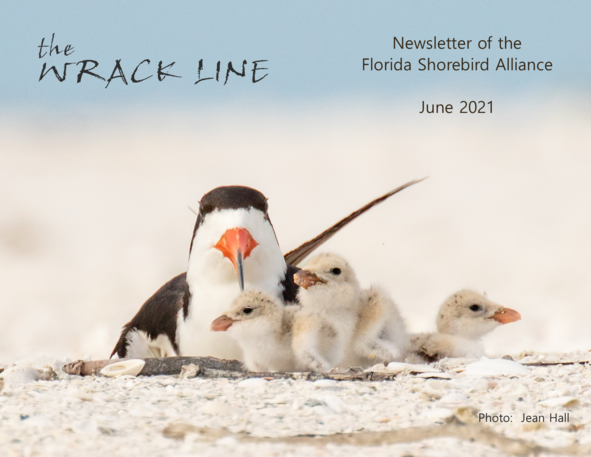Events:June 8: World Oceans Day Beach Stewardship Training:June 24, 7pm: July 4th Special Training (Pinellas and Sarasota counties). Register here. RemindersJune 10 - 16: the June count window for the Breeding Bird Protocol. Whenever possible, weekly surveys are preferred for routes with active nesting; it helps capture information about peak counts. All Summer: Beach stewards are needed at important beach nesting sites. Check out the map of local stewardship opportunities and contact us to get involved!
 Photography of shorebirds and seabirds along Florida’s shores is a popular activity for persons of all ages. Observing shorebirds and seabirds can be exciting, and admirers are often eager to photograph the charismatic birds that take residence on the beaches each year. However, photographing birds for our enjoyment does not need to come at the cost of their chronic disturbance. If you are one of the lucky people to encounter and photograph shorebirds and seabirds, please remember how to be a shorebird-friendly photographer. When photographing a bird on a nest: Remain outside the posted area. No part of you or your camera equipment should go beyond the string or signs. If the area around the nest is not staked off, you should remain far enough away to avoid disturbing the birds (typically 300 feet). If the birds show any sign of agitation as a result of your presence, quietly and slowly retreat until the birds no longer appear disturbed. Stay far enough away for the bird to remain on its nest. Back off immediately if you flush a bird. Sometimes birds nest near the edge of a posted boundary, so even if you are outside the string, if the bird responds to you, you’re too close! Scan for shorebird and seabird predators. Make sure there are no predators nearby such as raccoons, cats, and crows that may be attracted to human presence or scent. They are alert to movement, so by flushing a bird, you may inadvertently help predators notice birds that would otherwise have remained camouflaged. Stay 10 minutes or less. Too much time near the nest may unduly stress the birds. Be considerate and do not spend more than 10 minutes near the nest. If other photographers are present, try to coordinate your time near the nest, and leave the area together, so that the birds have at least three hours of undisturbed time. Don’t specify the nest’s exact location when sharing or publishing photos. Advertising the birds’ nesting location may draw additional disturbance to the nest. When photographing birds that are away from their nests, or birds with chicks: Stay at least 100 ft away from the birds. Wait for the birds to approach you for closer shots. Stay far enough away so the birds do not change their behavior in response to your presence.
Don’t “push” the birds around the beach. Birds need to be able to feed and rest without disturbance. Shorebird chicks must constantly forage to gain enough weight to fledge in time, so any time taken away from foraging can be harmful to their health and survival.
For more details, read "How to Be a Shorebird-friendly Photographer".
|
 Sea Turtle and Shorebird Monitors: When You're on the BeachSummer is in the air, and for shorebirds and sea turtles, eggs are on, or in, the beach. And that means Shorebird Alliance Partners and Marine Turtle Permit Holders (MTPH) are also on the beach. If you’re one of the persons working for the conservation of Florida’s sea turtles and shorebirds, there are a few things to remember during your time on the sand. Sea turtles access the beach at night to bury their eggs within the sand, usually ten inches or deeper. The eggs of shorebirds, however, are laid on the open sand. Also, unlike sea turtle hatchlings, flightless chicks remain on the beach until they are fledged – and they don’t just remain in the posted areas! Chicks of both colonial and solitary nesters can be anywhere on the beach from the waterline up to the dunes, and they can travel far from the original marked nest site. The primary defensive response for flightless chicks is to freeze and press against the sand surface, which makes them very vulnerable to foot and vehicle traffic. During the shorebird nesting season, Florida Shorebird Alliance partners post nesting areas by encircling the area with posts and flagging or twine. The time frame from nest initiation to fledging of seabird and shorebird chicks is typically no longer than 60 days and determines how long an area is posted. However, because nests are asynchronous (not all nests are initiated on the same day), if there is more than one nest within a posted area such as in a large seabird colony, this time frame may stretch out over a longer period. Because each posted area is unique, it is best for MTPH and shorebird monitors to coordinate closely to determine the anticipated completion date for nesting at any site. When surveying on the beach please remember to respect posted areas, as often there will be eggs and chicks on the ground. Any disturbance within the site could cause the adult birds to flush, leaving eggs and chicks vulnerable to predation, exposure to the intense heat from the sun, or starvation. Chicks may become separated from their parents during a disturbance event, or adults may permanently abandon a nest due to human disturbance. Seabirds and shorebirds are protected under state and federal laws, and there can be legal ramifications for anyone entering a posted area, even with the best intentions. MTPH that survey a beach with posted shorebird nests must be extra vigilant, both on an ATV and on foot, during early morning surveys to watch for shorebird chicks and fledglings. Sea turtle nest surveyors must respect the posted area, entering only if specifically authorized to do so by FWC staff at MTP@myfwc.com. It is still important to get accurate information on any sea turtle crawls that might occur within posted shorebird areas or adjacent to posted nests. Marine Turtle Permit Holders should observe the crawl to the degree possible from the outside of the posted area and install a marker outside the postings or away from the solitary nest to indicate the approximate location of the crawl or nest. Once the postings for the birds are removed, the MTPH can enter the area and post as large a section as needed for protection of any potential sea turtle nests. Sea turtle nest inventories should be done after the postings are removed. If you are a Marine Turtle Permit Holder or a shorebird monitor and have questions about posted areas, please contact shorebird@myfwc.com or mtp@myfwc.com and we will help you. Thank you for your work protecting Florida’s sea turtles and shorebirds! |

It's Chick Season!Chicks are hatching all over the state! Do you know how to enter your chick observations into the Florida Shorebird Database (FSD)? In the FSD, the place to enter chick observations depends largely on the species and location of the chick. If you see a solitary shorebird chick, first ask: is the chick inside or outside the nest cup? Most of the time, shorebird chicks will be observed outside the nest cup, which means you should enter the observation on the Roving Chick/Staging Young Form. In the very rare instances where you observe a shorebird chick still inside the nest cup, it is considered a nestling and can be recorded on your Shorebird Nest Form. If you see a seabird chick, first ask: is the chick within sight of a colony? Downy and feathered seabird chicks will always be within sight of their colony, but sometimes flight-capable seabirds can spend time “staging” beyond sight of their original colony. If the seabird chick is within sight of a colony, you can enter those chicks on the Seabird Colony Form. But if you see staging seabirds – flight-capable young that are out of sight of a colony – you can record them on a Roving Chick/Staging Young Form. For more details about age classes, check out the shorebird and seabird aging guides on the Monitoring Guidance section of the FSA website. As always, we are happy to help answer any questions about chick observations and data entry. If you’re unsure about anything, just email FLShorebirdDatabase@myFWC.com! 
|







No comments:
Post a Comment